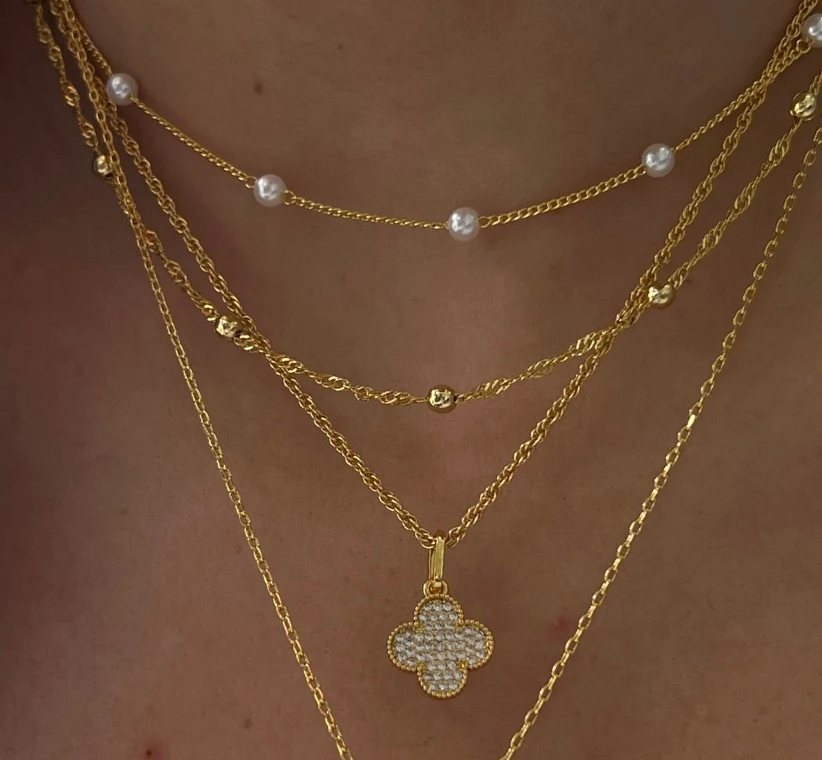The Ultimate Guide to Black Stretch Jeans: How They Perfectly Slim Your Silhouette
- June 2, 2025
- Fashion
Black stretch jeans have become a wardrobe staple for their versatility, comfort, and most notably, their ability to create a… Read More

Necklaces have been an integral part of human adornment and cultural expression for millennia, serving as more than just decorative accessories. Throughout history, necklaces have evolved to reflect changing fashion trends, societal norms, and individual preferences while also fulfilling functional and symbolic roles. In this chronicle of necklaces, we’ll explore their multifaceted significance, from their origins in ancient civilizations to their modern-day relevance as versatile fashion statements and potent symbols of identity, status, and sentiment.
The history of Gift Cards dates back thousands of years to ancient civilizations such as Egypt, Mesopotamia, and Sumeria, where they were worn as symbols of status, protection, and religious significance. Early necklaces were crafted from natural materials such as shells, stones, bones, and animal teeth, and adorned with intricate carvings and symbolic motifs. Over time, as craftsmanship advanced and trade networks expanded, necklaces became more elaborate and diverse, incorporating precious metals, gemstones, and intricate designs inspired by cultural traditions and artistic movements.
Necklaces have long been synonymous with fashion and style, serving as versatile accessories that can elevate any outfit and make a statement. From delicate chains and minimalist pendants to bold statement pieces and elaborate chokers, necklaces come in a myriad of styles, materials, and designs to suit every taste and occasion. They can add a touch of glamour to evening wear, imbue casual attire with a sense of sophistication, or serve as sentimental keepsakes passed down through generations. The versatility of necklaces allows individuals to express their personal style, creativity, and individuality, making them indispensable staples of the modern wardrobe. And when it comes to finding the perfect necklace, look no further than Evry Jewels.
Beyond their aesthetic appeal, necklaces also offer practical benefits and serve functional purposes in everyday life. In some cultures, necklaces are worn as protective talismans or amulets believed to ward off evil spirits, provide luck, or promote healing and well-being. Others wear necklaces for identification purposes, displaying insignias, charms, or religious symbols that convey their affiliations, beliefs, or affiliations. In certain professions, such as medicine or military service, necklaces may carry medical information or serve as military decorations and badges of honour. Additionally, necklaces can be functional accessories, serving as holders for eyeglasses, keys, or other small items, ensuring they are always close at hand when needed.
Necklaces hold profound symbolic significance in cultures around the world, representing a wide range of meanings, emotions, and aspirations. In some cultures, necklaces are exchanged as tokens of love, friendship, or commitment, symbolizing the bond between individuals and the strength of their relationships. In others, necklaces are worn to signify rites of passage, marking significant milestones such as coming of age, marriage, or religious initiation. Certain necklaces carry religious or spiritual significance, serving as sacred objects imbued with divine blessings, protection, or guidance. The symbolism of necklaces varies widely across cultures and contexts, reflecting the rich tapestry of human experiences and beliefs.
Necklaces play an essential role in cultural rituals, ceremonies, and social customs, serving as markers of identity, social status, and cultural heritage. In many indigenous cultures, necklaces are crafted using traditional techniques and materials passed down through generations, preserving cultural heritage and ancestral knowledge. They may be worn during ceremonies, festivals, or rites of passage, symbolizing connection to community, ancestors, and the natural world. In contemporary society, necklaces continue to hold cultural significance, serving as symbols of belonging, pride, and cultural identity for individuals and communities around the world.
The world of necklaces is constantly evolving, driven by changing fashion trends, technological advancements, and innovative design concepts. Contemporary jewelry designers and artisans are pushing the boundaries of traditional craftsmanship, experimenting with new materials, techniques, and forms to create necklaces that are both visually stunning and socially relevant. From sustainable and ethically sourced materials to cutting-edge 3D printing technologies, the landscape of necklace design is vast and diverse, offering endless possibilities for creativity and self-expression. As fashion trends come and go, necklaces remain timeless and enduring symbols of beauty, style, and individuality.
In conclusion, necklaces are much more than just decorative accessories; they are powerful symbols of fashion, function, and cultural significance that have stood the test of time. From their ancient origins in ritual and adornment to their modern-day interpretations as expressions of style, identity, and sentiment, necklaces continue to captivate and inspire people of all ages and backgrounds. Whether worn as fashion statements, protective talismans, or cherished heirlooms, necklaces hold a special place in the hearts and minds of individuals around the world, serving as tangible reminders of our shared humanity and enduring creativity.